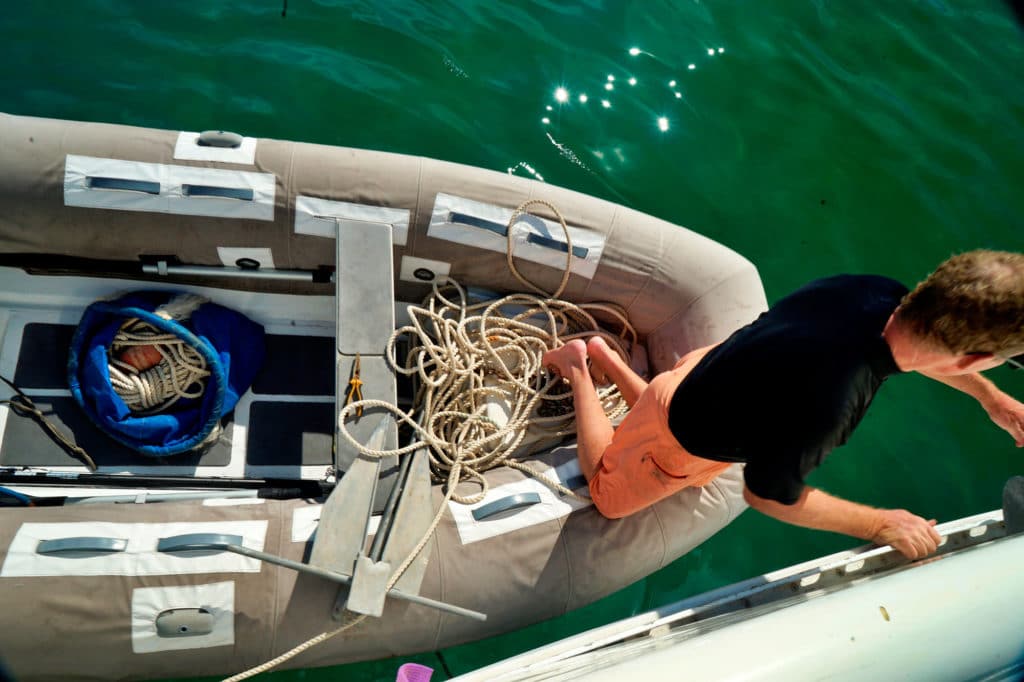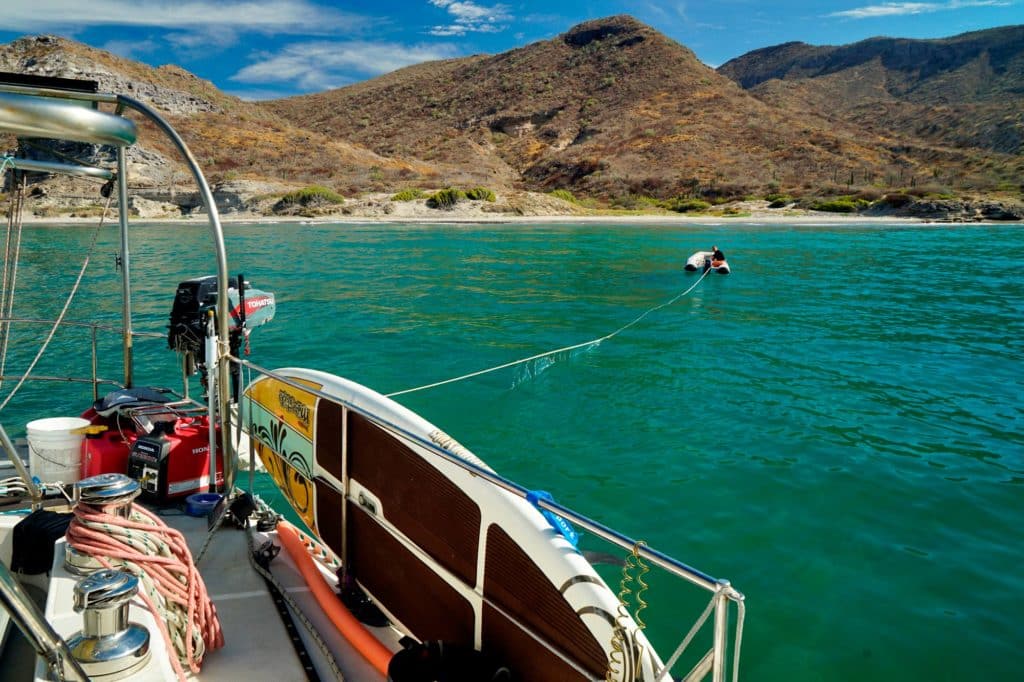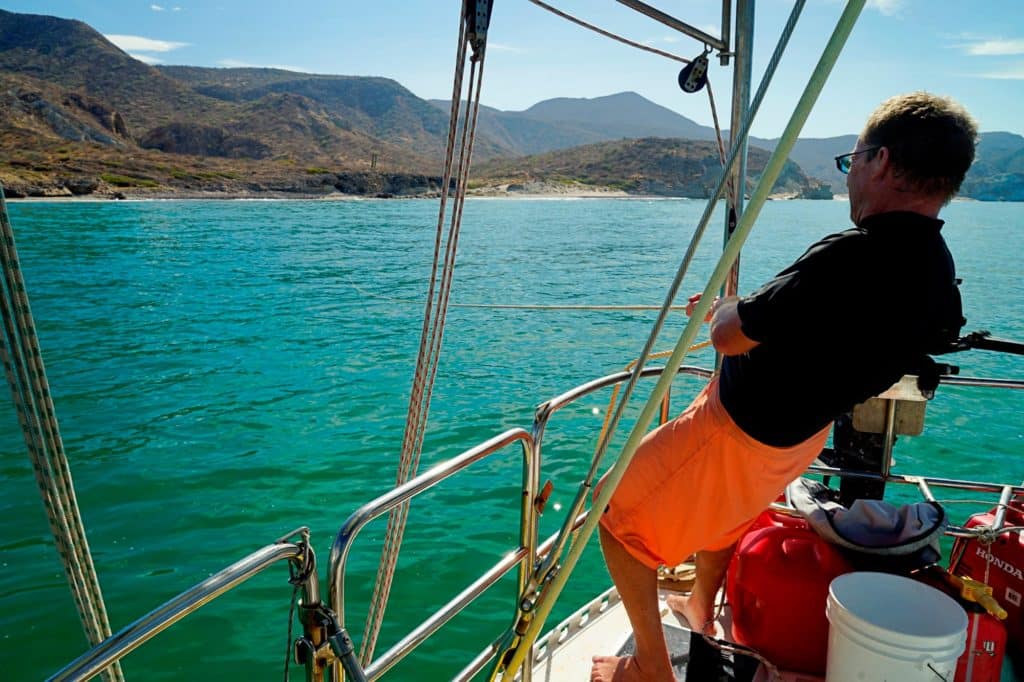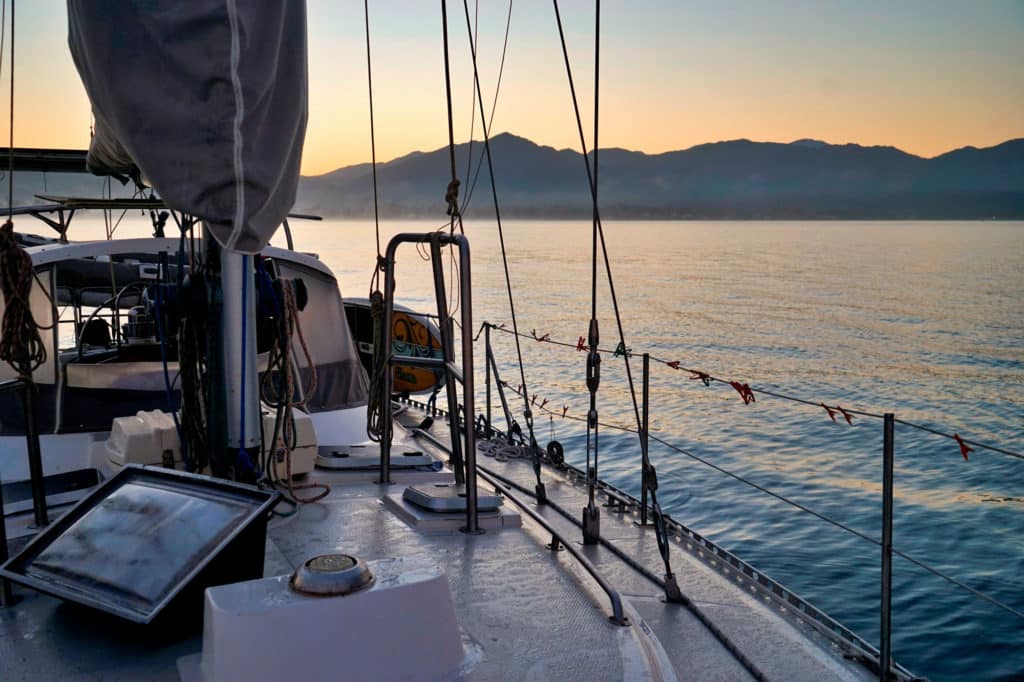
This story originally appeared on Sailing Totem.
Anchored well in the sandy bottom, Totem pointed nicely into the breeze blowing in from the Sea of Cortez. This orientation kept us perfectly aligned… to be beam-on the swell wrapping around the point. With a deep, gentle roll in the flat-looking water, a few unstowed books tumbled. Dangit! A beautiful anchorage can become miserable with misaligned wind and water.
It’s not only a problem for monohulls. We’ve been on a few cats where beam-on chop created enough jerking that sundowner beverages nearly had to be lashed in place. But yes, monos feel the inconvenience more often.
There are several solutions: you can leave the anchorage, accept the situation, or alter the boat’s orientation to reduce the motion. Of the latter, there are two methods. One is to secure a line to the anchor rode well forward of the bow, and then tension and secure it to a midships or stern cleat. This is sometimes called a winch bridle, or angle anchoring. It pivots the boat to a different angle when the line is adjusted to put the bow into the waves instead of the wind. The downside is that the wind is then beam-on, and if conditions get sporty (such as a garden-variety afternoon squall), means more windage / more force on the anchor, and causes the boat to sail wildly back and forth. We saw a boat in Dominica slicing so wildly back and forth enough that neighboring boats had to fend off! But the method is adequate in moderate conditions and a roomy anchorage.
Another solution to reorient the boat to swell is using a stern anchor. Of the 718 times we’ve anchored Totem, we’ve set a stern anchor 6 times. While that doesn’t rocket it to the top of skills list for preparing to set sail, it will feel like the most important technique in your world when you need it.
Physics behind rolling at anchor
At anchor, our boats are influenced by wind, waves/swell, and current. It’s helpful when they’re all aligned! Two out of three is more common and generally enough for comfortable anchoring. But each boat’s features cause it to respond differently.
A boat’s profile above and below the water line affect how the force of wind (windage) and force of water (waterage – why isn’t this a word?) push and shove it around at anchor. Despite being tucked in behind a reef at San Juanico on the coast of Baja some months back, that sneaky swell had us rolling… and a stern hook put it right. Here’s a quick primer on the process to set a stern anchor.
How to set a stern anchor
1. Set the primary anchor.
2. Estimate the length of rode needed. We use a scope of five or six times the depth where the anchor will be, plus stern height. Secure that length of rode to a stern cleat.

3. Transfer stern anchor and rode to dinghy. Be sure the rode is flaked so that anchor end is on the bottom and the boat-tied end on top. This allows it to cleanly pay out when motoring away from the mother ship.
4. Slowly drive the dinghy (be sure nothing can get snagged in the rode as it pulls out) in the direction you want to set the anchor so that the boat is oriented into the waves.
5. While the dinghy is getting to the anchor drop point, crew on the boat puts the engine in reverse. Slowly back the mother ship down until the primary anchor chain is pulled up fairly tight, and ideally maneuvered to be aligned (or near to it) to pointing into the waves.

6. In the dinghy, once nearly all of the rode is out, drop the stern anchor overboard.
7. Dinghy radios to mother ship that the stern anchor is down and they should go to neutral. Mother ship will spring forward, pulling the stern anchor rode tight and hopefully setting the stern hook.
8. Evaluate. Did that stern hook set well enough? Bottom contour and composition influence how the anchor sets. Adjust stern anchor rode tension to test the set and tweak the boat’s orientation to waves.
It’s never good to dash off after setting the primary anchor, and the same goes for a stern hook.

Anchor and rode choices
Does the anchor matter? Of course it does! Totem came with an adequate Danforth anchor, so it’s what we use. A Fortress anchor is also a fine option. It’s the same fluke-style anchor, but made in aluminum and can be disassembled to stow below. Just don’t lose the parts, as a boat in Chagos did at a critical moment when Jamie was trying to help them kedge off a reef.
A stern anchor rode setup is commonly 10 to 20 feet of chain and 150 to 200 feet of stretchy nylon line. Load on the rode is nothing like the primary anchor, so chain and rope diameters are smaller. Our setup on Totem uses 5/16″ chain and ½” 3-strand nylon. Anchoring in deeper water, or near coral and rocks, may lead to different choices. Just remember that handling stern-anchor gear can be awkward from a dinghy. It’s better to be a little light, than have sized-up gear that becomes unmanageable in tough conditions.
Considerations for using a stern hook
There are some additional considerations to setting a stern anchor.
First, is the rode extending out from the transom a hazard to vessel traffic? A dinghy going by the stern and not suspecting a stern anchor could run into trouble for the outboard, rode, or passenger. Consider attaching a float to the stern line to mark the hazard. We saw a passing dinghy snap the stern line on a boat in the Marquesas.
Is using a stern hook appropriate in the anchorage? If it’s a tight space and your orientation sets you up differently to other boats without stern anchors set, it’s probably not the right thing to do. Remember that they still swing when you don’t. It could be that setting a stern hook is the only appropriate choice. In Atuona, Hiva Oa, all vessels set a stern hook—both to stay pointed into swell and accommodate more boats in a small basin.

All of this applies to catamarans as well, with one variation. Attaching the stern anchor rode to one stern cleat is pretty far offset from centerline. A bridle arrangement helps center the rode between the hulls. This can be as simple as a secondary line attached to the rode with a rolling hitch, and secured to the opposite hull’s stern cleat.
Most important: have an escape plan, in case one of the variables (wind, swell, current) changes suddenly or dramatically. Consider trying a fender to the stern anchor rode so that one bailout plan could be to simply untie, and return to retrieve it later. Take care to NOT tangle the rode in a propeller!
Retrieving a stern anchor
It wouldn’t be right to end this without a note on getting the stern anchor back!
Hop back in that dinghy.
Untie the stern anchor’s rode from the boat. Be cautious though, it can have a lot of load on it. If so, reverse the mothership to ease the tension. Then pull the rode into the dinghy until you’re over the anchor.
Cross your fingers and hope it was set well enough but not TOO well, so you can pull it out! It helps to pull straight upwards over the shank.
If the anchor is really dug in, you might have to dive on it. Thankfully, we’ve only had this once…but that was the dark waters of Hiva Oa, worrying about sharks we couldn’t see. A trip line can be rigged to pull the anchor backward out of the bottom. It works but this also adds complexity and another hazard to the anchorage.
Stern anchoring on Totem
Exactly a year ago we were anchored in Matanchen Bay while pandemic news swirled. The wide curve of sand bordering this nook below San Blas was a good place to ride out uncertainty while staying dialed in: far from any crowds, but good connectivity from a nearby cell tower. Matanchen is also famous for its excellent, and exceptionally long, right-hand surf break. You’d be right to assume that surfing and mellow anchorages don’t often mesh! It wasn’t constant, but roll was enough to make life uncomfortable. Setting the stern hook transformed a rolly anchorage into an idyllic spot.

When stern anchoring works, it’s the magical remedy for taking a miserable anchorage and turning it into your next favorite place. It can be fodder for comic relief! It’s good to be mindful that what feels like a win in the moment could be a nightmare if conditions change! In either situation, knowing what to do makes this a good tool in the cruiser’s kit.








